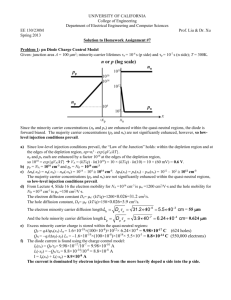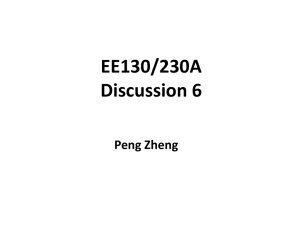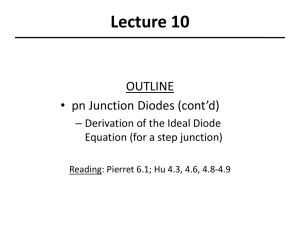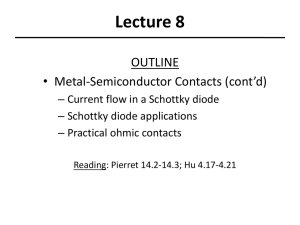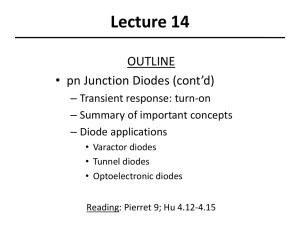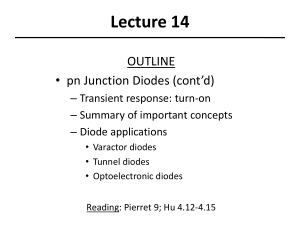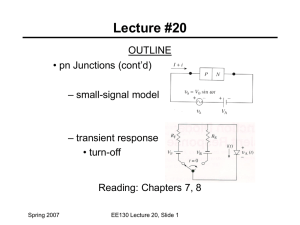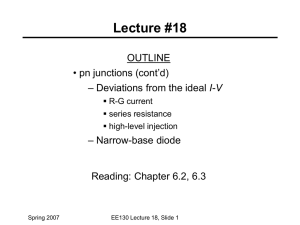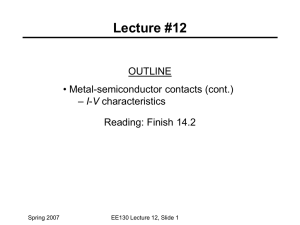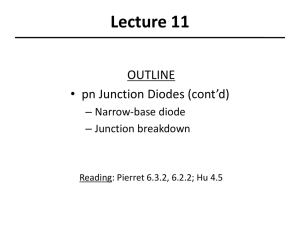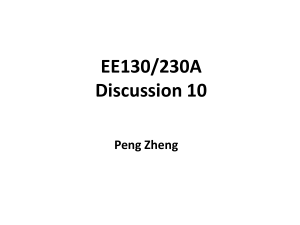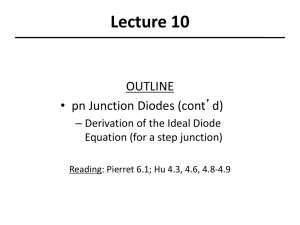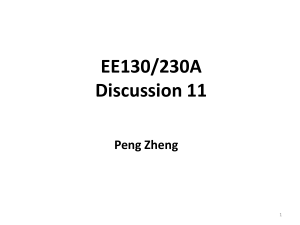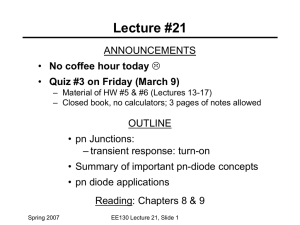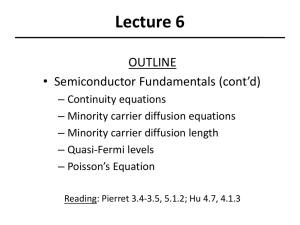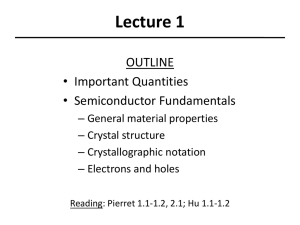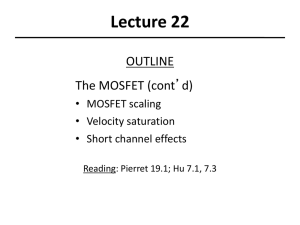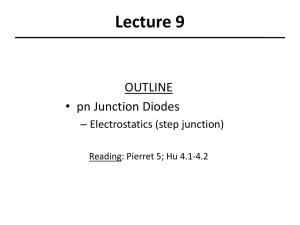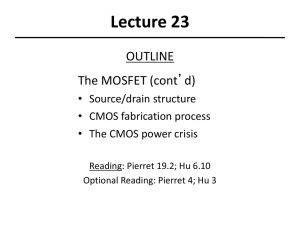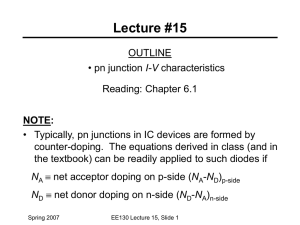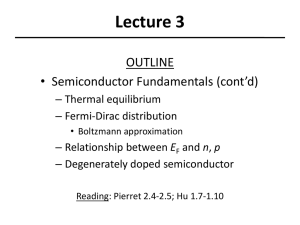EE130/230A Discussion 7 Peng Zheng
advertisement
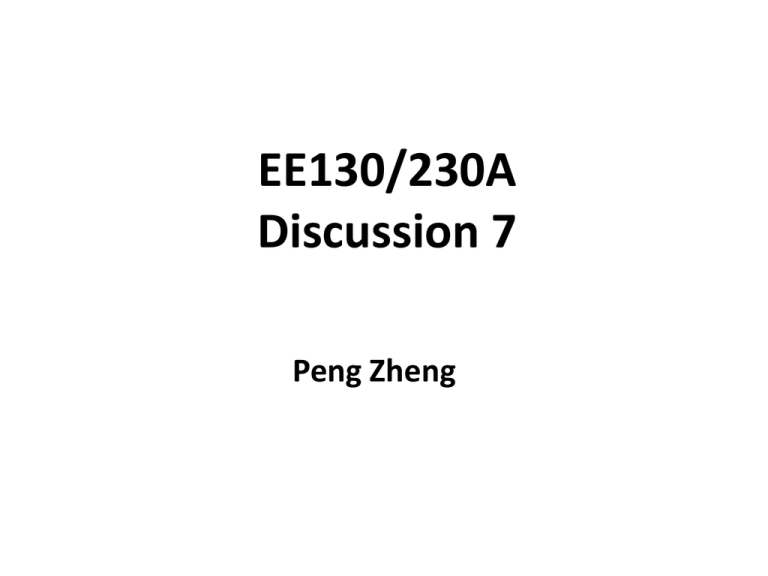
EE130/230A
Discussion 7
Peng Zheng
Minority-Carrier Charge Storage
• Under forward bias (VA > 0), excess minority carriers are
stored in the quasi-neutral regions of a pn junction:
QN qA
xp
n p ( x)dx
QP qA pn ( x)dx
xn
qApn ( xn ) LP
qAn p ( x p ) LN
EE130/230A Fall 2013
Lecture 13, Slide 2
Charge Control Model Summary
• Under forward bias, minority-carrier charge is stored in the
quasi-neutral regions of a pn diode.
– Long base:
ni2 qVA / kT
QN qA
e
1 LN
NA
ni2 qVA / kT
QP qA
e
1 LP
ND
– Narrow base:
1 ni2 qVA / kT
QN qA
e
1 WP
2 NA
1 ni2 qVA / kT
QP qA
e
1 WN
2 ND
EE130/230A Fall 2013
Lecture 13, Slide 3
• The steady-state diode current can be viewed as the
charge supply required to compensate for charge loss
via recombination (for long base) or collection at the
contacts (for narrow base).
– Long base (both sides): I
QN QP
τn
τp
QN QP
– Narrow base (both sides): I
τtr ,n τtr , p
where
τ tr ,n
2
WP
2 DN
and τ tr , p
2
WN
2 DP
Note that
EE130/230A Fall 2013
Lecture 13, Slide 4
LN DN
L
D
and P P
τn
LN
τ p LP
Sample Problem-Charge Control Model
Sample Problem-Charge Control Model
Since the minority carrier concentrations (np and pn) are enhanced within the quasi-neutral regions, the diode is
forward biased. The majority carrier concentrations (pp and nn) are not significantly enhanced, however, so lowlevel injection conditions prevail.
a) Since low-level injection conditions prevail, the “Law of the Junction” holds: within the depletion region and at
the edges of the depletion region, np=ni2 exp{qVA/kT}.
np and pn each are enhanced by a factor 1010 at the edges of the depletion region,
so 1010 = exp{qVA/kT} VA = (kT/q) ln(1010) = 10 × (kT/q) ln(10) = 10 × (60 mV) = 0.6 V.
b) pp = NA = 1016 cm-3 and nn = ND = 1018 cm-3
c) np(-xp) = np(-xp) – np0(-xp) = 1014 – 104 1014 cm-3. pn(xn) = pn(xn) – pn0(xn) = 1012 – 102 1012 cm-3
The majority carrier concentrations (pp and nn) are not significantly enhanced within the quasi-neutral regions,
so low-level injection conditions prevail.
d) From Lecture 4, Slide 17 the electron mobility for NA =1016 cm-3 is n =1200 cm2/Vs and the hole mobility for
ND =1018 cm-3 is p =150 cm2/Vs.
The electron diffusion constant Dn= n (kT/q)=1200×0.026=31.2 cm2/s.
The hole diffusion constant, Dp= p (kT/q)=150×0.026=3.9 cm2/s.
The electron minority carrier diffusion length Ln = Dn t n = 31.2 ´10-6 = 5.5 ´10-3 cm = 55 m
And the hole minority carrier diffusion length Lp = D p t p = 3.9 ´10-7 = 6.24 ´10-4 cm= 0.624 m
e) Excess minority carrier charge is stored within the quasi-neutral regions:
-19
-8
12
-4
-17
QP = qApn(xn) Lp = 1.6×10 ×(100×10 )×10 × 6.24×10 = 9.98×10 C
-19
-8
14
-3
-14
QN = qAnp(-xp) Ln = 1.6×10 ×(100×10 )×10 × 5.5×10 = 8.8×10 C
f) The diode current is found using the charge control model:
-17
-7
-10
Ip(xn) = QP/p= 9.98×10 /10 = 9.98×10 A
-14
-6
-8
In(-xp) = QN/n = 8.8×10 /10 = 8.8×10 A
-8
I = Ip(xn) + In(-xp) = 8.9×10 A
The current is dominated by electron injection from the more heavily doped n side into the p side.
Small-Signal Model Summary
C C J CD
I DC I 0 (e qVA / kT 1)
A s
Depletion capacitance C J
W
τI DC
Diffusion capacitance CD
kT / q
EE130/230A Fall 2013
I DC
Conductance G
kT / q
Lecture 13, Slide 7
R. F. Pierret, Semiconductor Device Fundamentals, p. 302
Sample Problem-Small Signal Model
-8
-8
From the previous problem, IDC= 8.9×10 A. The small-signal resistance R = 1/G =(kT/q)/ IDC=0.026/8.9×10
=2.9×105 .
Since the n-type side is degenerately doped (ND = 1018 cm-3), we should find the reduction in band gap
energy on the n side:
300
In your HW, it is
=35meV
EG 3.5 108 N1 3
T
not
degenerately doped.
The built-in potential is then
E EG kT NA
Vbi G
ln( ) = (1.12-0.035)/2 + 0.026×ln(1016/1010)=0.902V
2q
q
ni
The depletion width W
2 s (Vbi VA )
qNA
2 1012 (0.902 0.6)
0.194 m
1.6 1019 1016
s A
1012 100 108
5.15 1014 F
Depletion capacitance C j
5
W
1.94 10
t
10-6
Diffusion capacitance CD = n =
= 0.39 ´10-11 F
R 2.95 ´105
Total capacitance C=Cj+ CD = 0.39×10-11 F.
A schematic of the small-signal model is shown below.
Transient Response of pn Diode
• Suppose a pn-diode is forward biased, then suddenly turned
off at time t = 0. Because of CD, the voltage across the pn
junction depletion region cannot be changed instantaneously.
The time delay in switching between
the FORWARD-bias and REVERSE-bias
states is due to the time required to
change the amount of excess minority
carriers stored in the quasi-neutral regions.
EE130/230A Fall 2013
Lecture 13, Slide 9
R. F. Pierret, Semiconductor Device Fundamentals, Fig. 8.2
Decay of Stored Charge
Consider a p+n diode (Qp >> Qn):
pn(x)
i(t)
ts
t
vA(t)
R. F. Pierret, Semiconductor Device Fundamentals, Fig. 8.3
For t > 0:
dpn
dx
EE130/230A Fall 2013
x xn
i
0
qAD p
Lecture 13, Slide 10
ts
t
Qualitative Examples
Illustrate how the turn-off transient response would change:
Increase IF
Decrease p
Increase IR
i(t)
i(t)
ts
EE130/230A Fall 2013
t
i(t)
ts
Lecture 13, Slide 21
t
ts
t
